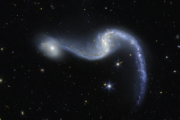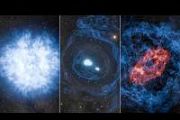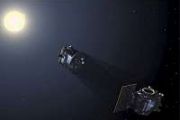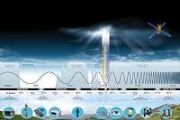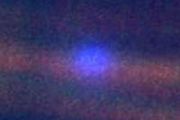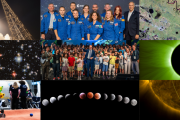
Copernical Team
Musk's megarocket faces crucial new test after failures
 Elon Musk's SpaceX is gearing up for the next test of its Starship megarocket on Sunday, after a string of recent failures that has prompted some observers to question its viability.
The world's most powerful launch vehicle is set to lift off from the company's Starbase in southern Texas at 6:30 pm local time (2330 GMT) for its tenth flight.
The mission aims to put the upper stage t
Elon Musk's SpaceX is gearing up for the next test of its Starship megarocket on Sunday, after a string of recent failures that has prompted some observers to question its viability.
The world's most powerful launch vehicle is set to lift off from the company's Starbase in southern Texas at 6:30 pm local time (2330 GMT) for its tenth flight.
The mission aims to put the upper stage t Week in images: 18-22 August 2025

Week in images: 18-22 August 2025
Discover our week through the lens
CerraCap backs Space Kinetic to accelerate space superiority and missile defense
 CerraCap Ventures has invested in Space Kinetic Corp., a cleared national security innovator based in Albuquerque, New Mexico. The move aligns with CerraCap's push to speed space defense technologies and bolster the United States strategic edge as space becomes increasingly contested
CerraCap Ventures has invested in Space Kinetic Corp., a cleared national security innovator based in Albuquerque, New Mexico. The move aligns with CerraCap's push to speed space defense technologies and bolster the United States strategic edge as space becomes increasingly contested BlackSky expands non Earth imaging partnership with HEO under new seven figure contract
 BlackSky Technology Inc. has signed a seven figure Gen 2 space domain awareness expansion contract with HEO to provide fully automated low latency non Earth imaging services for defense, intelligence and commercial missions. The agreement marks the fourth phase of the program, following full automation of the tasking to delivery process.
"BlackSky's high resolution Gen 2 high cadence monit
BlackSky Technology Inc. has signed a seven figure Gen 2 space domain awareness expansion contract with HEO to provide fully automated low latency non Earth imaging services for defense, intelligence and commercial missions. The agreement marks the fourth phase of the program, following full automation of the tasking to delivery process.
"BlackSky's high resolution Gen 2 high cadence monit AI assistant supports Chinese space station astronauts
 The crew of China's Tiangong space station recently conducted their third spacewalk with the help of a new artificial intelligence system named Wukong AI, marking the first use of a large-scale AI model aboard the orbital complex.
Delivered by the Tianzhou 9 cargo craft on July 15, Wukong AI arrived along with upgraded spacesuits, fresh produce, and other supplies. The system, named after
The crew of China's Tiangong space station recently conducted their third spacewalk with the help of a new artificial intelligence system named Wukong AI, marking the first use of a large-scale AI model aboard the orbital complex.
Delivered by the Tianzhou 9 cargo craft on July 15, Wukong AI arrived along with upgraded spacesuits, fresh produce, and other supplies. The system, named after Spacesuit milestone reached with 20 spacewalks on Chinese station
 The extravehicular spacesuit B aboard China's space station has achieved a major milestone by supporting 20 spacewalks, according to the China Astronaut Research and Training Center. Astronaut Chen Dong most recently used the suit on Aug 15 during the Shenzhou XX crew's third series of extravehicular activities.
This accomplishment marks the first time a Chinese spacesuit has met its exten
The extravehicular spacesuit B aboard China's space station has achieved a major milestone by supporting 20 spacewalks, according to the China Astronaut Research and Training Center. Astronaut Chen Dong most recently used the suit on Aug 15 during the Shenzhou XX crew's third series of extravehicular activities.
This accomplishment marks the first time a Chinese spacesuit has met its exten Researchers use electrochemistry to boost nuclear fusion rates
 Using a small bench-top reactor, researchers at the University of British Columbia (UBC) have demonstrated that electrochemically loading a solid metal target with deuterium fuel can boost nuclear fusion rates.
Large-scale magnetic confinement fusion-which puts plasmas under extreme temperatures and pressure-is being widely explored as a method for clean energy generation. The experiment p
Using a small bench-top reactor, researchers at the University of British Columbia (UBC) have demonstrated that electrochemically loading a solid metal target with deuterium fuel can boost nuclear fusion rates.
Large-scale magnetic confinement fusion-which puts plasmas under extreme temperatures and pressure-is being widely explored as a method for clean energy generation. The experiment p Space Force establishes Systems Delta 85 to strengthen space defense integration
 Space Systems Command has officially activated Systems Delta 85, a new organization designed to unify acquisition and operational support for space defense missions. The command and activation ceremony took place Aug. 8 at Peterson Space Force Base, with Col. Jason West assuming leadership of SYD 85 under the authority of U.S. Air Force Brig. Gen. Michelle Idle.
The new SYD 85 brings toget
Space Systems Command has officially activated Systems Delta 85, a new organization designed to unify acquisition and operational support for space defense missions. The command and activation ceremony took place Aug. 8 at Peterson Space Force Base, with Col. Jason West assuming leadership of SYD 85 under the authority of U.S. Air Force Brig. Gen. Michelle Idle.
The new SYD 85 brings toget Another US military mini shuttle launches on a secret mission
This request seems a bit unusual, so we need to confirm that you're human. Please press and hold the button until it turns completely green. Thank you for your cooperation!
Press and hold the button
If you believe this is an error, please contact our support team.
185.132.36.159 : b2f5de18-cd2e-4179-938e-65e8cb9f
SpaceX launched secretive X-37B US military space drone
 A SpaceX Falcon 9 rocket will blast into space on Thursday night carrying the US military's secretive X-37B drone on its eighth mission.
The rocket is due to launch at 11:50 pm (0450 GMT on Friday), according to SpaceX, which said a backup window is available at the same time the following day.
The US Space Force has said the drone's mission will include "a wide range of test and exp
A SpaceX Falcon 9 rocket will blast into space on Thursday night carrying the US military's secretive X-37B drone on its eighth mission.
The rocket is due to launch at 11:50 pm (0450 GMT on Friday), according to SpaceX, which said a backup window is available at the same time the following day.
The US Space Force has said the drone's mission will include "a wide range of test and exp 











